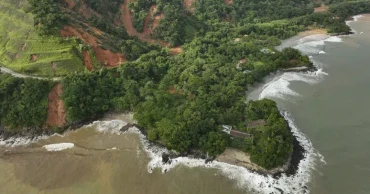deluge
A dam collapses and thousands face the deluge — often with no help — in Russian-occupied Ukraine
For days, the Ukrainian teenager has waited in the attic, just down the street from the cemetery of her flooded town, marking time with her 83-year-old grandfather and two other elderly people and hoping for help to escape the deluge of a catastrophic dam collapse.
But help is slow in coming to Oleshky, a Russian-occupied town across the Dnieper River from the city of Kherson with a prewar population of 24,000, according to those stranded and their desperate Ukrainian rescuers. Russian forces are taking rescuers' boats, they say. Some say the soldiers will only help people with Russian passports.
Also Read: Drone footage of collapsed dam shows ruined structure, devastation and no sign of life
"Russian soldiers are standing at the checkpoints, preventing (rescuers) from approaching the most-affected areas and taking away the boats," said one volunteer, Yaroslav Vasiliev. "They are afraid of saboteurs, they suspect everyone."
So 19-year-old Yektarina But and the three elderly people with her simply wait, along with thousands of others believed to be trapped by floodwaters spread across 600 square kilometers (230 square miles) of the Kherson region. About two-thirds of the flooded areas are in territory occupied by Russia, officials said.
The group in the attic have no electricity, no running water, no food. The battery on But's cellphone is dying.
"We are afraid that no one will know about our deaths," she said in a brief cellphone interview, her voice trembling.
"Everything around us is flooded," she said. "There is still no help." Her grandfather, who had suffered a stroke, was running out of medicine, she said. One woman with her, a neighbor's grandmother, could not move on her own.
Others have been turned away from rescue.
Also Read: Zelenskyy visits area flooded by destroyed dam as five reported dead in Russian-occupied town
Viktoria Mironova-Baka said she has been in touch from Germany with relatives stuck in the flooded region.
"My relatives said that Russian soldiers were coming up to the house today by boat, but they said they would only take those with Russian passports," she told The Associated Press. Her grandmother, aunt and more than a dozen other people are taking shelter in the attic of a two-story house.
Details of life in Russian-occupied Ukraine are often unclear. The AP could not independently verify reports of boat seizures or that only Russians were being evacuated, but the account is in line with reporting by independent Russian media.
It's a sharp contrast to Ukrainian-controlled territory flooded by the dam collapse. Authorities there have aggressively evacuated civilians and brought in emergency supplies. On Thursday, President Volodymyr Zelenskyy traveled to the area to assess the damage. Russian President Vladimir Putin "has no plans at the current moment" to visit affected Moscow-occupied areas, Kremlin spokesman Dmitry Peskov told journalists.
also read: Ukrainian dam breach: What is happening and what's at stake
This region has suffered terribly since Russia invaded Ukraine early last year, enduring sometimes-relentless artillery and missile attacks.
The latest disaster began Tuesday, when the Kakhovka hydroelectric dam, roughly 80 kilometers (50 miles) upstream from Oleshky, collapsed, sending torrents of water down the Dnieper River and across the war's front lines.
Officials say more than 6,000 people have been evacuated from dozens of inundated cities, towns and villages on both sides of the river. But the true scale of the disaster remains unclear for a region that was once home to tens of thousands of people.
At least 14 people have died in the flooding, many are homeless, and tens of thousands are without drinking water.
The floods ruined crops, displaced land mines, caused widespread environmental damage, and set the stage for long-term electricity shortages.
Ukraine says Russia destroyed the dam with explosives. Russia accuses Ukraine of destroying it with a missile strike.
A drone flown Wednesday by an AP team over the dam's wreckage revealed none of the scorch marks or shrapnel scars typical of a bombardment. The bulk of the dam itself is now submerged, and The AP images offered a limited snapshot, making it difficult to rule out any scenario. The dam also had been weakened by Russian neglect and water had been washing over it for weeks. It had been under Russian control since the invasion in February 2022.
Compounding the tragedy, Russia has been shelling areas hit by the flooding, including the front-line city of Kherson. On Thursday, Russian shelling echoed not far from a square in Kherson where emergency crews and volunteers were dispensing aid. Some evacuation points in the city were hit, wounding nine people, according to Ukrainian officials.
The floodwaters have irrevocably changed the landscape downstream, and shifted the dynamic of the 15-month-old war.
Oleshky Mayor Yevhen Ryshchuk said that by Thursday afternoon water levels were beginning to fall, but roughly 90% of the city remained flooded.
Ryshchuk fled after Russian forces tried to force him to collaborate, but he remains in close contact with people in and around the city.
Russia says it is helping the region's civilians. Moscow-appointed regional Gov. Vladimir Saldo claimed over 4,000 people had been evacuated from the flood zones. He shared a video showing empty beds in shelters prepared for evacuees.
Ryshchuk dismisses such talk.
He said some people trying to leave flooded areas were forced back by Russian soldiers who accused them of being "waiters" — people waiting for Ukraine to reclaim control of the region.
Others, who called the Russian-controlled emergency services, were told they would have to wait for help, he said.
"That's it," he said. "Yesterday, some Russians came in the morning, took a few people off the roofs, filmed a video, and left. That's everything they have done as of today."
The help that made it through has been scattered.
Ukrainian military footage, for instance, showed their forces dropping a bottle of water from a drone to a boy trapped with his mother and sister in the attic of their home near Oleshky. Ukrainian soldiers later evacuated the family and their pets to the city of Kherson, National Police reported.
Much of the help is being organized by volunteers communicating on the encrypted app Telegram. Messages about stranded people, often trapped on the roofs of their houses, appear in these groups every few minutes. Most are posted by relatives in safer areas.
Just one of these volunteer groups has a map showing over 1,000 requests to locate and rescue people, mostly in Oleshky and the nearby town of Hola Prystan.
A woman helping with one of the groups, who spoke on condition her name not be used for fear of reprisals from the Russian occupiers, shared a message with an AP journalist.
"We were looking for a person named Serhii Borzov," the message read. "He was found. Unfortunately, dead. Our condolences to the relatives."
2 years ago
Brazil deluge toll hits 44 as search continues for missing
The death toll from flooding and landslides in Brazil’s southern state of Sao Paulo reached 44 on Tuesday as searches continued for dozens still missing.
Most of the search was concentrated in the mountainous coastal municipality of Sao Sebastiao where 43 deaths have been recorded. Firefighters still hoped to find people alive in the rubble of houses slammed by landslides during a weekend deluge, said Sao Sebastiao city hall worker Pedro de Rosario.
“Hope is the last thing that dies, so we have a lot of hope," de Rosario said. “There are still people buried.”
Seven bodies have been identified and released for burial, while nearly 800 people are homeless and 1,730 people have been displaced, the Sao Paulo state government said in a statement.
Members of the armed forces joined the search and rescue efforts, and starting Thursday the Navy will build a hospital with up to 300 beds to help relief efforts, Gov. Tarcisio de Freitas said at a news conference in Sao Sebastiao on Tuesday.
Authorities are digging through the mud and clearing roads, but parts of the highway connecting Rio de Janeiro state with Sao Paulo’s port city of Santos are still blocked by landslides. Another road connecting the city of Bortiga to inland Sao Paulo remains completely blocked.
Brazil’s President Luiz Inácio Lula da Silva visited the region on Monday. In remarks to reporters, he called for people living in the hillside areas to be relocated to safer regions.
Precipitation in Sao Sebastiao surpassed 600 millimeters (23.6 inches) during a 24-hour period over the weekend, among the largest such downpours ever in such a short period in Brazil.
Around 7.5 tons of aid items including food, water and hygiene kits have already been distributed to the victims, the state government of Sao Paulo said.
The affected area, on the northern coast of Sao Paulo state and famous for beach resorts flanked by mountains, is a frequent Carnival destination for wealthy tourists who prefer to stay away from massive street parties in big cities.
2 years ago



